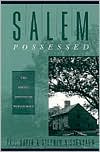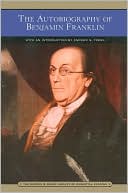Salem Possessed: The Social Origins of Witchcraft
Search in google:
PrefaceSalem Village in the Seventeenth Century: A ChronologyAbbreviations Used in the Notes Prologue: What Happened in 16921. 1692: Some New Perspectives2. In Quest of Community, 1639-16873. Afflicted Village, 1688-16974. Salem Town and Salem Village: The Dynamics
\ New York Review of BooksAn illuminating and imaginative interpretation…of the social and moral state of Salem village in 1692. A sensitive, intelligent, and well-written book.\ \ \ \ \ \ The AtlanticThe authors' whole approach to the Salem disaster is canny, rewarding, and sure to fascinate readers interested in that aberrant affair.\ \ \ \ American Historical ReviewA large achievement. This book is progressive history at its very best, with brilliant insights.\ \ \ \ \ \ Canadian Historical ReviewThis short book is a solid contribution to the understanding of the 1692 witch trials. The authors use impressively rich demographic detail to support the thesis that the witch trials are best explained as symptoms of typical social tensions in provincial towns at the time. According to Boyer and Nissenbaum, Salem villagers played roles determined by economic, geographic, and status interests.\ — Richard Ekman\ \ \ \ \ \ Journal of Women in Culture and SocietyAn important, imaginative book that brings new insights to the study of the 1692 witchcraft outbreak in Massachusetts. Building on Charles Upham's Salem Witchcraft (1867), Boyer and Nissenbaum explore decades of community tension and conflict in order to explain why Salem was the focus of this episode. The authors reveal a complex set of relationships between persons allied with the growing mercantile interests of Salem Town and those linked to the subsistence-based economy of outlying Salem Village.\ — Carol Karlsen\ \ \ \ \ \ William and Mary QuarterlyA provocative book. Drawing upon an impressive range of unpublished local sources, Paul Boyer and Stephen Nissenbaum provide a challenging new interpretation of the outbreak of witchcraft in Salem Village. They argue that previous historians erroneously divorced the tragic events of 1692 from the long-term development of the village and therefore failed to realize that the witch trials were simply one particularly violent chapter in a series of local controversies dating back to the 1660s. In their reconstruction of the socio-economic conditions that contributed to the intense factionalism in Salem Village, Boyer and Nissenbaum have made a major contribution to the social history of colonial New England… [They] have provided us with a first-rate discussion of factionalism in a seventeenth-century New England community. Their handling of economic, familial, and spatial relationships within Salem Village is both sophisticated and imaginative.\ — T. H. Breen\ \ \ \ \ \ American historical ReviewA large achievement. This book is progressive history at its very best, with brilliant insights.\ \ \ \ \ William and Many QuarterlySalem Possessed is a provocative book. Drawing upon an impressive range of unpublished local sources, Paul Boyer and Stephen Nissenbaum provide a challenging new interpretation of the outbreak of witchcraft in Salem Village… A major contribution to the social history of colonial New England… Sophisticated and imaginative.\ \ \ \ \ \ New York Review of BooksAn illuminating and imaginative interpretation... of the social and moral state of Salem village in 1692. A sensitive, intelligent, and well-written book.\ \ \ \ \ American Historical ReviewThis is an 'inner history' of Salem Village that aims to raise the events of 1692 from melodrama to tragedy...It is a large achievement. This book is progressive history at its best, with brilliant insights, well-organized evidence, maps, and footnotes at the bottom of the page.\ — Cedric B. Cowing\ \ \ \ \ The AtlanticThe authors' whole approach to the Salem disaster is canny, rewarding, and sure to fascinate readers interested in that aberrant affair.\ \ \ \ \ William and Mary QuarterlyA provocative book. Drawing upon an impressive range of unpublished local sources, Paul Boyer and Stephen Nissenbaum provide a challenging new interpretation of the outbreak of witchcraft in Salem Village. They argue that previous historians erroneously divorced the tragic events of 1692 from the long-term development of the village and therefore failed to realize that the witch trials were simply one particularly violent chapter in a series of local controversies dating back to the 1660s. In their reconstruction of the socio-economic conditions that contributed to the intense factionalism in Salem Village, Boyer and Nissenbaum have made a major contribution to the social history of colonial New England...[They] have provided us with a first-rate discussion of factionalism in a seventeenth-century New England community. Their handling of economic, familial, and spatial relationships within Salem Village is both sophisticated and imaginative.\ — T. H. Breen\ \ \ \ \ Canadian Historical ReviewThis short book is a solid contribution to the understanding of the 1692 witch trials. The authors use impressively rich demographic detail to support the thesis that the witch trials are best explained as symptoms of typical social tensions in provincial towns at the time. According to Boyer and Nissenbaum, Salem villagers played roles determined by economic, geographic, and status interests.\ — Richard Ekman\ \ \ \ \ Journal of Women in Culture and SocietyAn important, imaginative book that brings new insights to the study of the 1692 witchcraft outbreak in Massachusetts. Building on Charles Upham's Salem Witchcraft (1867), Boyer and Nissenbaum explore decades of community tension and conflict in order to explain why Salem was the focus of this episode. The authors reveal a complex set of relationships between persons allied with the growing mercantile interests of Salem Town and those linked to the subsistence-based economy of outlying Salem Village.\ — Carol Karlsen\ \ \ \ \ William and Many QuarterlySalem Possessed is a provocative book. Drawing upon an impressive range of unpublished local sources, Paul Boyer and Stephen Nissenbaum provide a challenging new interpretation of the outbreak of witchcraft in Salem Village... A major contribution to the social history of colonial New England... Sophisticated and imaginative.\ \








